
5 Important Standards Maintenance Professionals Should Be Aware Of
Standards-based systems and processes provide distinct benefits when compared to proprietary ones, because standards envelop tried-and-true methods that users can incorporate for their own purposes. These benefits include interoperability across systems, easier replication and reuse of systems and best practices, as well as technological longevity.
Maintenance systems and processes are no exception. Maintenance standards incorporate proven methods to best perform tasks such as cleaning, lubrication, repairs, components’ replacement, data collection and more.
They can also instruct professionals on how to create comprehensive checklists of maintenance tasks, as well as on how to structure them into integrated maintenance programs.
Standards are useful when applied to technological systems. For example, they can boost the development of interoperable systems that can exchange data and services to boost the replication of maintenance solutions. Such data exchange and sharing is key to sharing visualizations across stakeholders and supporting new cost-effective ideas for remote maintenance.
Overall, standards-based systems and processes provide a safe path to successful maintenance practices in a highly diverse landscape of different plants, equipment, and processes.
There are a host of maintenance-related standards, which are developed by various organizations such as the International Standards Organization (ISO), the International Electrotechnical Commission (IEC), the American Nation Standards Institute (ANSI) and others.
These standards cover both maintenance procedures and systems, including emerging cyber-physical systems that are part of industry digitization. The latter systems have recently expanded the number and scope of maintenance related standards, since they have given rise to processes for collecting, exchanging and processing data.
Given the large number of standards, it would be difficult for one professional to educate himself on all suggested practices. Rather, practitioners tend to selectively focus on limited sets of standards, notably the ones that are suitable for their maintenance tasks at hand. In the following paragraphs, we present five important standards, which maintenance experts should know about.
1. ISO 55000 Asset Management Standards
Plant equipment and components are physical assets, and fall under the umbrella of asset management systems and disciplines.
Asset management is about coordinating and optimizing the management of an asset across its whole lifecycle, including selection, acquisition, development, maintenance, renewal and disposal processes.
ISO 55000 standards are available in various languages, including English, French, Spanish, Russian, Chinese, Japanese, Dutch, Swedish, Brazilian and Portuguese.
ISO 55000 comprises three standards for asset management, namely:
- ISO 55000, which illustrates the scope and merits of asset management while also introducing terms and definitions of the standard.
- ISO 55001, which specifies requirements for integrated and effective asset management systems, similar to the way ISO 9001 specifies quality management requirements.
- ISO 55002, which provides implementation guidelines for asset management systems that adhere to previous standards of the ISO 55000 family.
In addition to outlining asset management processes and their implementation, ISO 55000 provides in practice a framework for auditing existing asset management implementations in terms of completeness, while also suggesting improvements to existing processes.
As an example, the Assetivity consulting and training organization has been auditing the asset management processes of Hydro Tasmania (i.e., Australia’s leading producer of renewable energy) as a means of assessing their compliance with ISO 55000 and providing recommendations for further improvement.
2. ISO 13374 on Condition Monitoring and Diagnostics of Machines
Efficient data sharing and distribution is at the heart of maintenance systems and processes, including condition-based, preventive and predictive maintenance.
Moreover, data interoperability is a prerequisite for exchanging data across different systems, but also for deploying systems in a plug-and-play fashion with minimal integration effort.
The ISO 13374 series of standards is beneficial to combine a variety of information. It provides unified and interoperable ways for processing, communicating and presenting data across different maintenance systems and in a vendor-independent way. ISO 13374 consists of four parts, dealing with:
- Presentation of general guidelines for data communication and processing (Part 1)
- Data-processing requirements (Part 2)
- Communication requirements (Part 3)
- Presentation requirements (Part 4)
Maintenance companies such as Turbomonitoring list ISO 13374 are among the main standards that can be used for collecting and processing vibration data as a means of determining the health status of their machinery, including relevant design faults or damages. Vibration and damage analysis is indeed one of the most prominent applications of ISO 13374.
3. MIMOSA Open Information Standards
MIMOSA is a not-for-profit trade association which develops open information standards for Operations and Maintenance (O&M) in sectors such as manufacturing, fleet, and facility environments.
MIMOSA comprises a wide range of standards that span almost all aspects of data exchange and integration across diverse O&M systems.
MIMOSA CCOM (Common Collaborative Object Model) is an information model for the exchange of asset related information which eases interoperability between systems. Based on an XML compliant model, it enables systems to exchange data electronically, much in the same way the popular EDI (Electronic Data Interchange) model provides the means for exchanging information between electronic commerce systems and transactions.
Note that one of the MIMOSA standards (namely OSA-CBM) specifies a detailed implementation of ISO-13374 standards outlined above, including detailed data specifications for the functionality blocks of the ISO standard.
As such, the MIMOSA standards can also be used for ensuring interoperability across different maintenance datasets (i.e. data sets stemming from different systems and sensors), but also for facilitating data sharing across maintenance stakeholders.
4. ANSI TAPPI TIP 0305-34:2008
This standard is specified as part of Technical Information Paper TIP 0305-34 and provides guidelines for creating maintenance checklists on a daily, weekly or monthly basis.
In practice, maintenance engineers and users are expected to customize these checklists to the needs of their plant taking into account machines, equipment, physical configurations and other characteristics of the plant.
Documented research efforts and industrial case studies have underlined the importance of maintenance checklists towards focused and effective maintenance. The TAPPI TP 0305-34:2008 standard provides a practical approach on how to compile and maintain a relevant checklist.
5. Industrial Internet Consortium Reference Architecture
In earlier posts, we referred to the trend of digitizing industry, including opportunities to leverage the functionalities of the emerging Internet-of-Things (IoT) and BigData technologies.
The Industrial Internet Consortium Reference Architecture (IICRA) defines the structuring principles that drive the integration of Industrial Internet applications, as part of the emerging digitization of the industry.
The IICRA represents a joint effort between major industrial and IT players worldwide, reflecting their common vision for product interoperability and simplified development of industrial internet systems. The architecture supports use cases in various sectors including energy, healthcare, manufacturing and transportation.
The IICRA provides the means for developing flexible and interoperable maintenance applications, such as predictive maintenance. In particular, it defines connectivity requirements, as well as data representation and distribution requirements. The latter requirements can usually be fulfilled based on the integration of the Object Management Group's Data Distribution Service for Real-time Systems (DDS).
This has given rise to the specification and implementation of IICRA compliant data sharing platforms. The latter is used by system integrators, OEMs, device platform vendors and Cloud service providers to provide integrated internet-of-things solutions for vertical markets such as healthcare, energy, transportation and industrial automation.
Know The Correct Maintenance Standards to Follow
As mentioned earlier, the above list of standards is by no means exhaustive. Nevertheless, it provides an indication of the depth and breadth of maintenance-related standards that are currently available.
The list also presents a set of standards that can substantially support the functionalities of the advanced systems (BigData, IoT).
Needs and data mediums are constantly changing in organizations. When modifying your current maintenance practices to accommodate these changes, consider both existing and emerging maintenance-related standards to determine which standards would best be applied to your organizational structure.
What are the maintenance standards used in your organization? How have they helped you improve maintenance processes?
It’s worth listing your problem areas. There might be standards that could help deal with these issues that you may want to explore.
Interested in a maintenance solution that is configurable to both your business rules and industry standards? Request a demo of the Prometheus platform or contact us today.

